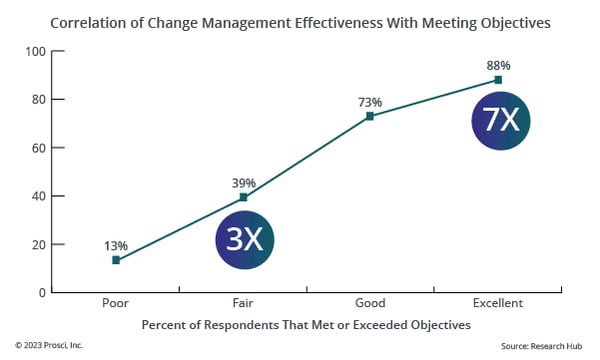Cost-Benefit Analysis of Change Management

5 Mins
Updated: October 17, 2025
Published: August 23, 2018

The logic is sound: projects and initiatives ultimately require individuals to do their jobs differently. The research is clear: the likelihood of success increases with effective change management.
Yet, some organizations are still reluctant to fully invest in and commit to change management. Many practitioners still encounter challenges with discussions about investments in time, resources and budget. In fact, Prosci's benchmarking research revealed that 76% of participants had to justify change management to leaders.
How can you overcome this challenge? One of the clearest ways to justify change management in terms leaders understand is through cost-benefit analysis.
Cost-Benefit Analysis Overview
The cost-benefit analysis for change management is not unlike those organizations conduct on a regular basis. Your goal is to demonstrate the relationship between the costs of managing the people side of change and the benefits you will reap from applying a structured approach to enabling impacted employees to engage, adopt and use the change. You will only receive the buy-in and investment necessary to apply change management if you can "tip the scale" by showing that the real and tangible benefits of change management outweigh the costs.
The research findings on the cost of change management are straightforward. But the benefits side of the equation is where the discussion can be tricky. To enhance the cost-benefit analysis, you can draw upon five specific benefit perspectives to make your case for change management:
- Three people-side ROI factors – Faster speed of adoption, higher ultimate utilization, and higher proficiency. Change management drives project ROI.
- Cost avoidance – Poorly managing change is costly to the project and the organization. Change management is a cost-avoidance tactic.
- Risk mitigation – Individuals, the project and the organization are all at risk when change is poorly managed. Change management is a tool to mitigate risks.
- Benefits realization insurance – Consider how much of the value of the project ultimately depends on people doing their jobs differently. Change management provides benefits realization insurance.
- Probability of meeting objectives – Data shows that projects with effective change management in place are more likely to meet objectives, stay on schedule, and stay on budget. Change management increases the probability of meeting objectives.
Costs of Change Management
Applying change management on a project takes time, energy and resources. According to Prosci research, the primary cost components of change management include:
- Change management resources (people)
- Training
- Communications
- Travel
- Time
- Change management materials
In addition to primary cost components, which were identified most frequently, secondary costs include:
- Consultant fees
- General expenses
- Event costs (e.g., workshops, group meetings, "lunch and learn" events, road shows, and town hall meetings)
- Reinforcement and recognition costs
To tip the scale toward buy-in and investment in managing the people side of change, the benefits of change management must outweigh these cost components.
Benefits of Change Management
Perspective 1. Three people-side ROI factors
Change occurs at the individual level. Prosci's ROI of change management model focuses on three people-side factors, which contribute to or limit the value a change delivers to the organization. The questions you can ask to assess these factors for your project include:
- Speed of adoption – How fast do people adopt the new processes or behaviors?
- Ultimate utilization – How many impacted employees made the change (and how many did not)?
- Proficiency – How effective were employees at following the new processes or behaviors?
These three factors are unique to your particular change but universal in terms of impacting project ROI. Unfortunately, many project teams make implicit assumptions about or fail to consider the people side of their change. For example, a team supporting a large IT implementation that gives users new interfaces might implicitly and erroneously assume that all users (100% ultimate utilization) will begin expertly using the system (extremely high proficiency) the day that the system goes live (instantaneous speed of adoption).
When the three people-side factors are added to the business case and ROI calculations, you can highlight the importance of change management. The three factors can even be used to conduct a sensitivity analysis to generate numeric values for the impact the people-side factors have on ROI. (For instance, if speed of adoption was over six weeks instead of three, and 15% of users did not adopt the system, the ROI for the project would actually be X instead of Y.)
The three people-side ROI factors can help you:
- More clearly define the individual changes required by a project at its initiation
- Calculate the impact of slower speed of adoption, lower ultimate utilization, and lower proficiency—and position change management as a tool for delivering business results in concrete terms
- Elevate the discussion and document assumptions early in the process related to the people side of change
Perspective 2. Cost avoidance
We incur significant and quantifiable costs when changes are poorly managed, at both the project and the organizational levels. In addition to the extra costs of fixing the people-side issues that creep up if we ignore change management up front, the organization fails to derive the value it needs from the project in the first place. Change management is an effective cost-avoidance technique we can apply on our projects.
Costs to the ORGANIZATION if change is poorly managed:
- Productivity plunges (deep and sustained)
- Impact on customers
- Impact on suppliers
- Loss of valued employees
- Morale declines
- Decline in quality of work
- Resistance to change
- History of failed change
- Stress, confusion and fatigue
- Change saturation
Costs to the PROJECT if change is poorly managed:
- Project delays
- Missed milestones
- Project put on hold
- Resources not made available to project team
- Budget overruns
- Obstacles appear unexpectedly
- Rework required on project design
- Project fails to deliver on objectives
- Project is fully abandoned
- Loss of work by project team
Costs if the change is NOT IMPLEMENTED:
- Expenses not reduced
- Efficiencies not gained
- Revenue not increased
- Market share not gained
- Waste not eliminated
- Regulations not met resulting in fines, penalties, etc.
Additionally, the organization loses the investment made in the project when the project does not deliver results.
When change management is applied effectively, these costs can be avoided or minimized. Some of the costs are difficult to quantify, such as declines in morale, but other costs are concrete and easily quantified.
Perspective 3. Risk mitigation
Another perspective, similar to the cost-avoidance perspective, is to outline the potential risks to the project and the organization associated with the people side of change. Risk management on projects is a well-developed discipline.
If your organization already conducts extensive risk assessments on projects, you can work to position "people-side risk" alongside other risks, such as financial, technology, schedule and dependency risks. If a project being planned has a high "people-side risk" component, applying a structured approach to change management is the right risk-mitigation technique.
Perspective 4. Benefits realization insurance
Much of the expected value from the most important and most strategic changes in the organization is tied to how people do their jobs. Applying a structured change management approach is like taking out an insurance policy against the goals and objectives of the project, superficially the portion that depends on employee adoption and usage.
Here, the context for showing the value of change management is tied to the overall value the project is working to achieve. The project objectives outlined in the project charter, business case or project plan are a good starting point. For each objective, ask yourself, "Is meeting this objective dependent on people doing their jobs differently?" The answer to some of the questions might be no, such as a change that lowers maintenance contract costs for a new piece of technology. But many of the objectives will be tied directly to the people side of change.
For these objectives, you can ask the follow-up question, "What percentage of these benefits result from people doing their jobs differently?" This is the amount of benefit you can "insure" by applying a solid change management approach (and the amount of the benefit you are leaving uninsured by not investing in change management).
Perspective 5. Probability of meeting objectives
The final benefit perspective, probability of meeting objectives, is tied to the growing body of data which shows that more effective change management results in a higher likelihood of delivering intended results.
The graph below correlates change management effectiveness with meeting or exceeding objectives. Created with data from thousands of change management professionals around the world, this correlation shows that projects with excellent change management are seven times more likely to meet objectives than those with poor change management. Even those with fair change management were three times more likely to succeed.

The Power of Cost-Benefit Analysis
When discussing the value and importance of change management, a cost-benefit analysis can be a powerful framework. Although these benefits are not necessarily sequenced in the order that you would use them, selecting the most beneficial benefit perspectives for your specific audience, change, organization and culture will enable you to build the strongest, most effective case for change management. By focusing on the concerns of your audience and connecting change management to success through a cost-benefit analysis, you can tip the scale to gain commitment and investment for change management.



